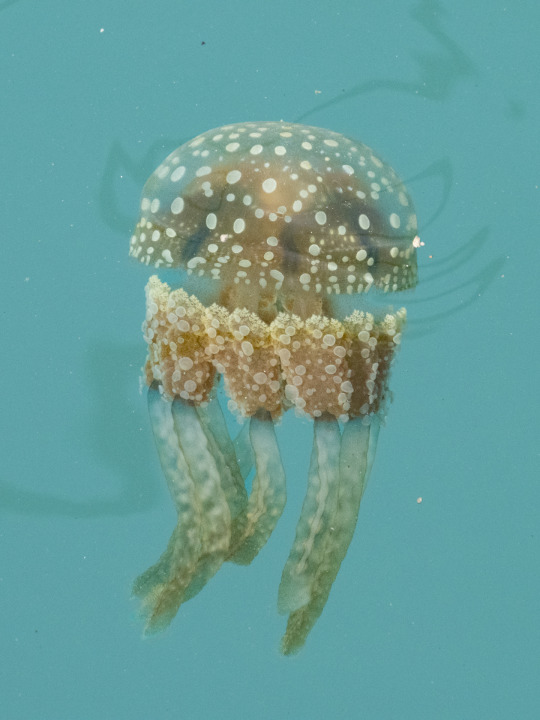#mastigias papua
Text
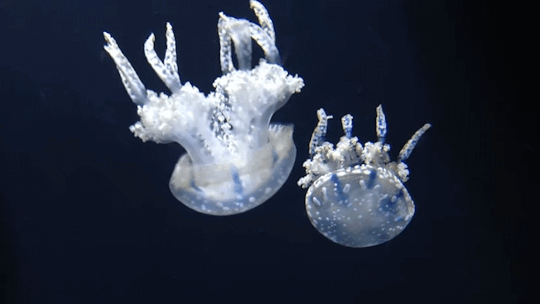
mastigias papua
147 notes
·
View notes
Text
The Vancouver Aquarium
Recently, I had the privilege and honour of visiting the Vancouver Aquarium!! It was very nice, and I'd like to give my honest review :)
Jellyfish Exhibit Rating:
Diversity - 7/10 - Only limited to Rhizostomeae and Semaeostomeae jellyfish (no combs or hydrozoans), but they get extra points for showing the rare "Stalked Jellyfish"
Presentation - 7/10 - Most exhibits had more jellyfish per square meter than normal so it was very pretty. One seemed kind of sad though.
Learning - 10/10 - Accurate information paired with engaging visuals, along with dedicated and knowledgeable staff. Here's a shout out to Noah I love him so much 🙏🙏
can we also appreciate how at every opportunity they get, the staff will thank the indigenous nations by name (there are multiple) that have owned and taken care of the land that the aquarium resides in? I respected that a lot haha.
So to start... I believe we entered at an auspicious day (even though it wasn't the weekend, when the jelly touchpool tanks are open)

That's right!! A local school was visiting the aquarium at the same time we were ^-^!! How exciting is that? I felt so much nostalgia haha... I wish I could've done something like this in elementary school ;w;
OK, so going into the aquarium I was already very excited, and seeing this made me gasp !! :>
(unfortunately, I spooked my mother, so um. Yeah)

Unfortunately they 1) Do not currently show the Phacellophora camtschatica in the aquarium and 2) call it the "Fried Egg Jelly" (actually, it's not too big of a deal but I prefer to call it the "Egg Yolk Jelly" since the Mediterranean Jelly resembles a fried egg.

Hey, did you know that the Association of Zoos and Aquariums recently released a jellyfish care guide? I ended up quoting it when I talked to one of the staff, hehe
Now, most of their exhibits are divided by world region- but the jellyfish (as with most exhibits it seems) are grouped into one... except for the Papua Jellyfish, which is the first tank placed in the Tropical Exhibits.

It's verrrry large (larger than any rhizostomid exhibit I've seen) and there are many, many jellyfish! Unfortunately the strong light and deep blue background made it pretty difficult to get good individual pictures (all of mine came out blurry :<), but they were so cute and small.
The jellies often bumped into the ground, and one was swirling around on the bottom, unable to get back into the flow (perhaps it was in-between the two circular currents?). Anyways something told me that this exhibit wasn't as well-looked after as the other ones :<

I did see a couple of really broken ones (sorry for the bad lighting, but here was a jellyfish that had most of its bell ripped up), and it just broke my heart. Most of the jellyfish were in fine condition, though, so I think it's just the normal ripped bells and appendages that you can find in any jellyfish exhibit.
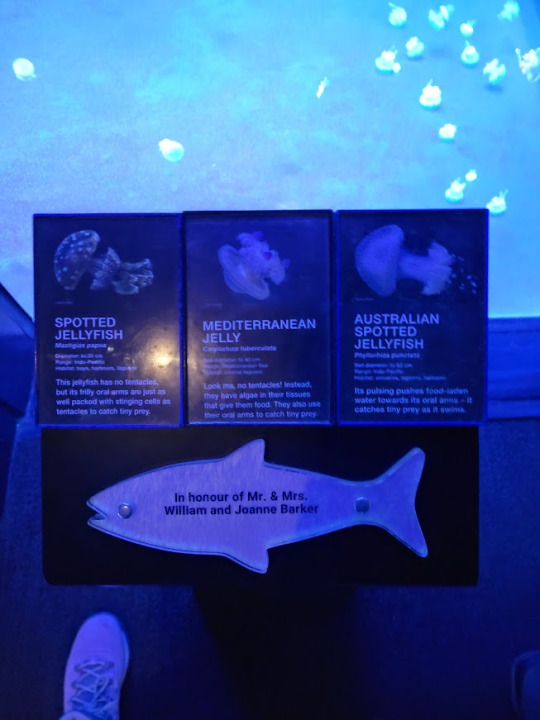
Curiously enough, however, this exhibit shows information cards for three different jellies when in reality there is only one species (The "Spotted Jellyfish") in the tank. I'll explain my theory why later when I get to them.

JELLYFISH HALL!!! There are many glowing sea nettles hanging from the ceiling, along with two life-sized lion's mane jellyfish!! :). The lion's manes also glow in different colours.
Also, if you notice, there's a very large crowd gathered in front of the sea nettle exhibit- and that's because I was INCREDIBLY, INCREDIBLY lucky to stop by RIGHT when they were doing a live jellyfish feeding. I cannot even begin to articulate how fortunate I was to accidentally stumble upon this.

Anyway, here's the obligatory jelly card haha :)

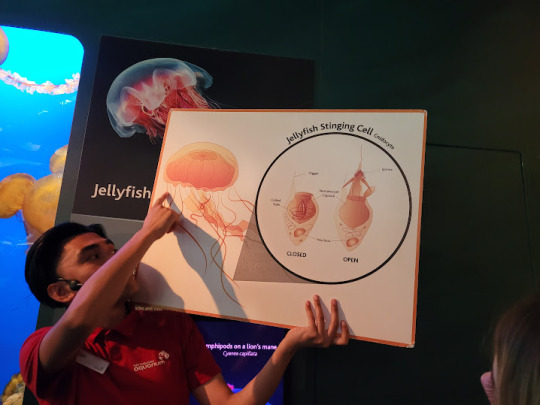
Here is speaker Noah, a 3rd year in his Marine Conservation degree showing us how amazing jellyfish are. I appreciate him a lot he gave me a lot of good information, which I'll just list down here:
The liquid inside of the measuring cup is in fact Jellyfish Food!
Usually, they are fed Artemis sp. naupili (sea monkeys, as he said it, or brine shrimp), but there were some other goodies added into the mix as well- like squid and herring.
This was all mixed in with a bit of gelatin- as sea nettles prefer to eat their food in bigger chunks.
These sea nettles are not fed with moon jellyfish- though the AZA Jellyfish Handbook does recommend to do that since sea nettles are medusivoric, and require jellyfish in their diet to grow properly. Apparently, the gelatin acts as an adequate substitute ^-^!!
Also Noah knows about the Monterey Bay Aquarium let's give him a round of applause ^-^!!! He said i should go there but. Well. I already did :3.
I could've went into more detail about the Cnidocyte explanation, but I'm probably not the best person to be teaching total beginners and children about jellyfish because I'd be way too technical (I was literally the only person in the crowd who was cheering lmao).

Here's a screenshot of the feeding video I took! (I'll upload the full feeding video if there's popular demand for it haha)
Anyways, after that excitement... it was time to look at the rest of the jellies.

This was the sign in front of the moon jelly exhibit. I just thought it was interesting to see what the aquarium defined as "Jellyfish" (this definition can vary from aquarium to aquarium)
Here, we can see that the Vancouver Aquarium considers Comb Jellies, Molluscs, and Salps as jellyfish. (this is more inclusive than my own personal definition- which excludes molluscs haha)


There was a bigger tank (that I did not take a full picture of... stupid Donut) that did include the Mediterranean and Australian Spotted jelly. They actually looked... a lot bigger in person than I thought, haha.
Now, I think the reason why these jellies were not roomed with the Papua jellies was because while they were originally a part of the exhibit, the two jellies actually outgrew the tank became too big to room with the small Papua jellies. These were housed in a tank that was about as big (if not bigger) than the Papua jelly tank- and there were not as many jellies per square meter in here.
Still weird that they kept the information cards about the jellies though... I guess it would've been too unsightly to remove?
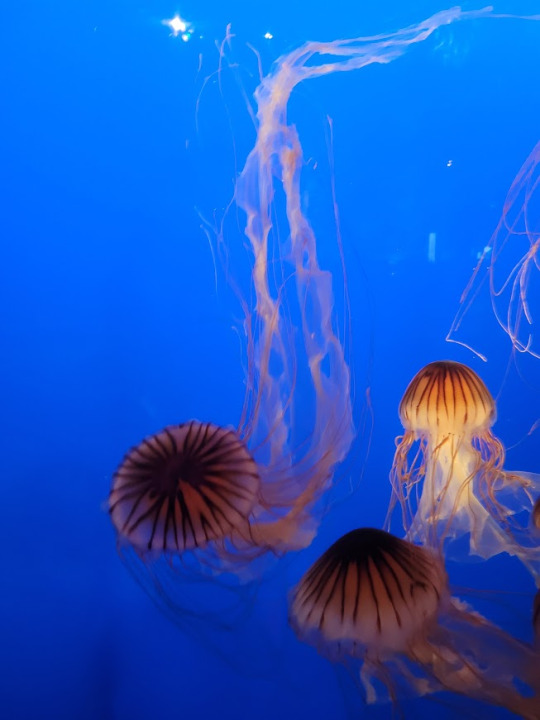
Ok, I also forgot to take a full view picture of this exhibit but don't be fooled by the pretty jellyfish. This exhibit was kind of... lacking, imo. I can only really describe it with a diagram of sorts.

This is a circular tank, but I'm guessing there were two opposing currents on either side. All of the sea nettles had migrated to the right current, making that half look too crowded and the other side completely empty. It didn't help that when all of the jellyfish were on the very shaded bottom, the entire tank was dark :(.
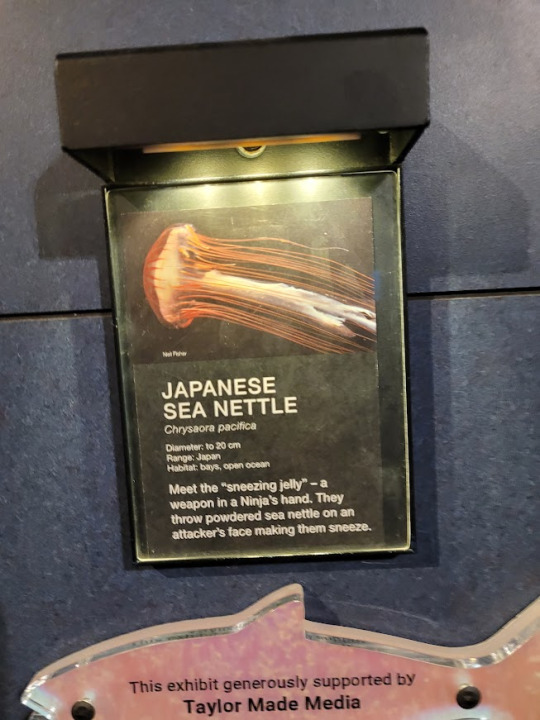
// Can we just say that them mentioning one of the Japanese names of the jellyfish is AWESOME? I've only seen this on the japanese wikipedia haha- though there was no mention of "Ninjas," only in military warfare in the Sengoku Period by Sanada Nobushige. Well. I'll correct my statement if it ends up being wrong later.

Quick break to visit my hero, Mackenzie Neale :). I'm a big fan of your work!!
Alright, now to visit the Moon jelly exhibit (it was honestly one of the most densely packed tanks I had ever seen- very impressive :>)
I made an instagram reel going over the sexual dimorphism of moon jellies- maybe I'll post it on here if I feel like it haha :3


^^ They have more infographics like this but this is the only one I took a picture of... awe :<.
OK, so with all of the main jellyfish out of the way... now started the hardest part of my journey: Finding the elusive, rare Staurozan (Stalked) jellyfish. These are so rare, apparently they're difficult for even scientists to get their hands on. I absolutely had to see them for myself.
Unfortunately... I kept running around in circles trying to find it (I had asked a staff member earlier where the exhibit was... but I forgot lol. I ended up having to ask two more people. It's tucked away in an unmarked Polar exhibit btw :>!!

Here was the gift shop I ended up visiting, there was a Japanese Sea nettle with a heart on it- awww
Anyways, I promise, after like 20 minutes of searching... I finally found the polar exhibits!!
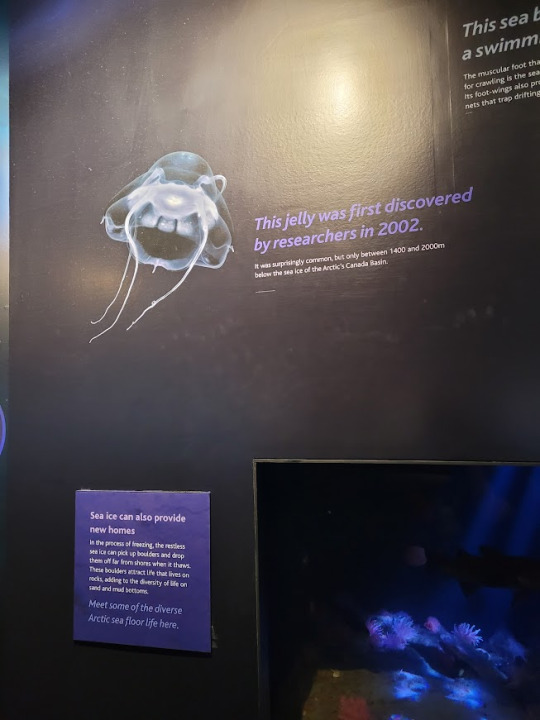
They had (one) hydrozoan jellyfish here... and it was a picture. An unnamed picture. For the record, it's called the "Battering Ram Jellyfish," according to Lisa-Ann Gershwin. It's a part of the Narcomedusae group, which have similarly positioned tentacles.
And now, in another fit of I did a dumb... I didn't take a picture of the two wall tanks... because the Vancouver Aquarium HAD to be confusing with them for some reason :/

this is the tank on the left! It has the Stalked Jellyfish card......... but the tank itself has NO Stalked Jellyfish...? I had NO idea why and it's driving me mad.
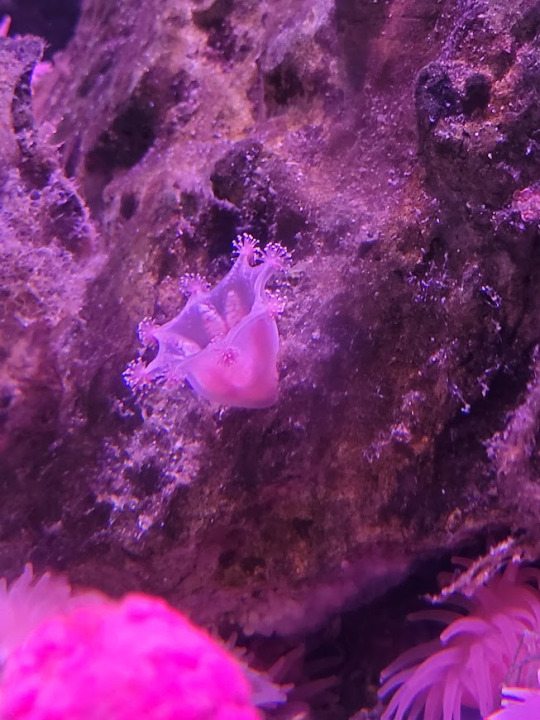
This tank was to the RIGHT of the tank with the card (ie. A TOTALLY SEPARATE TANK), BUT THESE ONES WERE THE ONES THAT HAD STAUROZOA?????... I have no words.
I actually ended up noticing them first because of their weird "firework-like" structure was different from the other corals, but I didn't know if they were actually staurozoa until I saw the card. Anyways, very confusing, but definitely the most magical and rewarding experience you could have in the aquarium. I'll leave out the directions to find this place so if anyone decides to visit the aquarium, they can just look for the staurozoa themselves :>
... and finally, that ends our jelly tour of the Vancouver Aquarium. Before you head home, though, why not pick up a cute little eco-friendly jelly plush on your way out?

She's a beauty, that's for sure!
#.aquarium reviews#.professor jellyfish speaks#jellyfish#pro tip: order tickets ahead of time. We paid $30 CAD more than we could've because we bought on the day of#by the way! this is the first time I've seen a Mediterranean Jelly in person. I'm in awe... they're so beautiful#also if you have a student id. BRING IT. There's student discounts :)#phacellophora camtschatica#aurelia aurita#cotylorhiza tuberculata#chrysaora fuscecens#mastigias papua#phyllorhiza punctata#chrysaora pacifica#lucernaria sp.#you have NO idea how happy I am to be tagging lucernaria this is the highlight of my entire trip istg
15 notes
·
View notes
Text
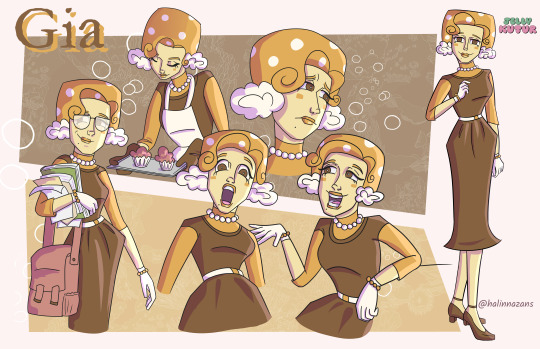
Instagram: @halinnazans
#illustration#jellyfish#ilustracion#digital art#webcomic#character design#character sheet#kawaii#mastigias papua#spotted jellyfish
0 notes
Text

Spotted lagoon jelly | Mastigias papua
X
194 notes
·
View notes
Note
turns out one of my friends is afraid of jellyfish so i'm trying to help xem out a bit, do you have any suggestions on cute + harmless jellies i could show xyr? other than the obvious moon jelly lol
in lieu of me not being on my laptop right now, I've compiled a list of harmless looking jellies in nonthreatening positions to help you and your friend on your journey :)
The first types of jellies I'd like to recommend are Rhizostomeae jellyfish, which have relatively mild stings and short oral arms, absent of long tentacles, and thus look nonthreatening (though I'd recommend showing shots of them from the side- Rhizostomeae means "many mouths" and they can look kind of scary from a bottom view)
Here are some examples!
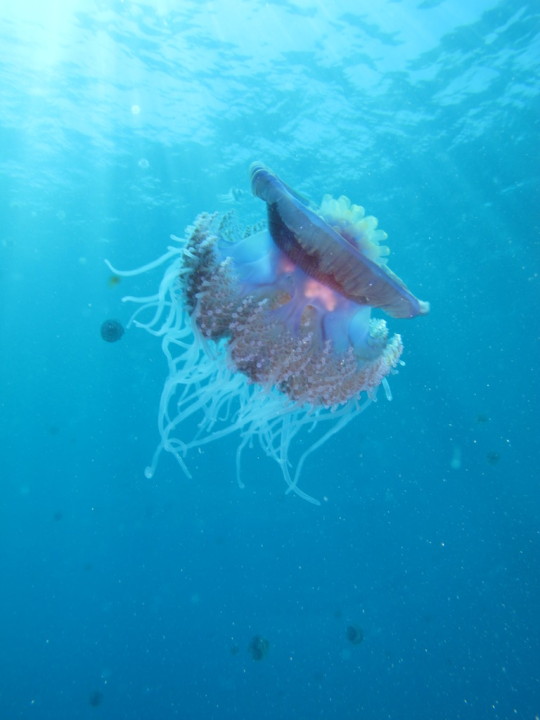


From top to bottom:
Cauliflower Jellyfish (Cephea cephea), Fried egg jellyfish (Cotylorhiza tuberculata), and Cabbagehead jellyfish (Stomopolus melagidaris)
We also have the famous Palau jelly (Mastigias Papua), which is even more nonthreatening and cute thanks to their mild stings, if any, and the yellow zooxanthellae that lines their body, giving them food

At the end of the Rhizostomeae category we have the Upside down jelly (Cassiopeia sp.) and this specific picture of the Flame jellyfish (Rhophilema esculentum)
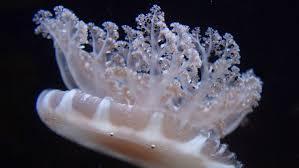
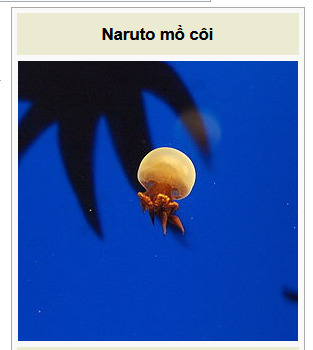
I suggest showing xem exclusively side views of these jellies, as a full view of their oral arms is probably a little freaky, ehe...
The flame jellyfish usually only looks pretty scary but this particular one (paired with the caption "Orphan no parents") makes me pity it quite a bit, lol
I'm going in assuming that your friend is scared of most "conventional types of jellyfish", so I'll stay away from Sea Nettles and Lions manes (they do have numerous, long, and painful tentacles anyway)

Comb jellies (specifically the Lobed and Beroe varieties) are also a great option, granted you don't tell xem the creepier parts of them. Comb jellies are also aggressive proponents of queer rights, constantly displaying the rainbow with the movement of their cilia and many being simultaneous hermaphrodites (or male and female at the same time). These guys just don't do gender.
They also have no nematocysts, instead trapping prey with "sticky trap" cells, as Lisa-Ann Gershwin likes to call them.
Now for the final stretch, I'll show you some Hydroazoan jellies (categorized by the numerous peripheral tentacles on their bell, much like a moon jellyfish). They can vary on how scary they look, so I'll just put the nonscary images I have readily available to myself

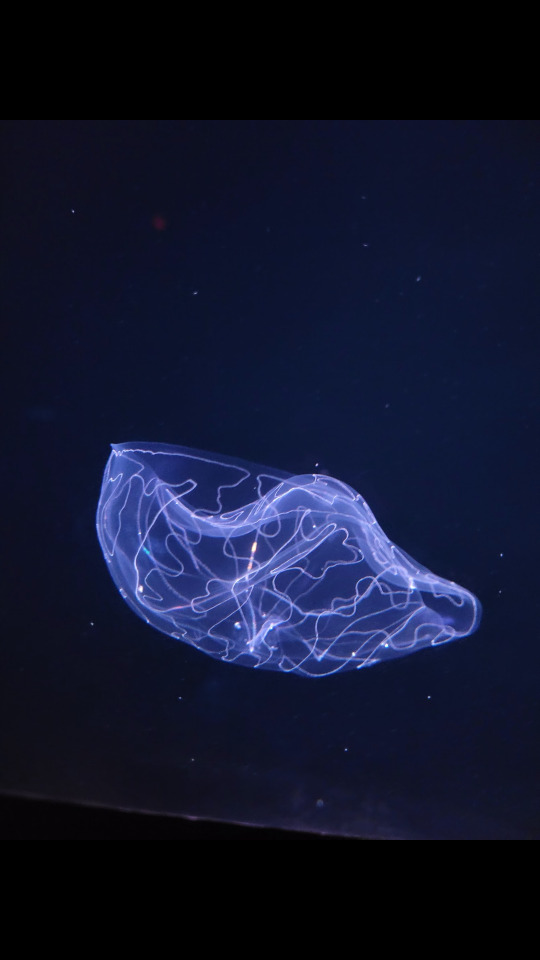
Here, we have the freshwater/peach blossom jellyfish, found pretty much worldwide, and the snow globe jellyfish (a picture I took myself at the monterey bay Aquarium ehe 😎).
I think they're just cute, haha.
One last jellyfish for the road:
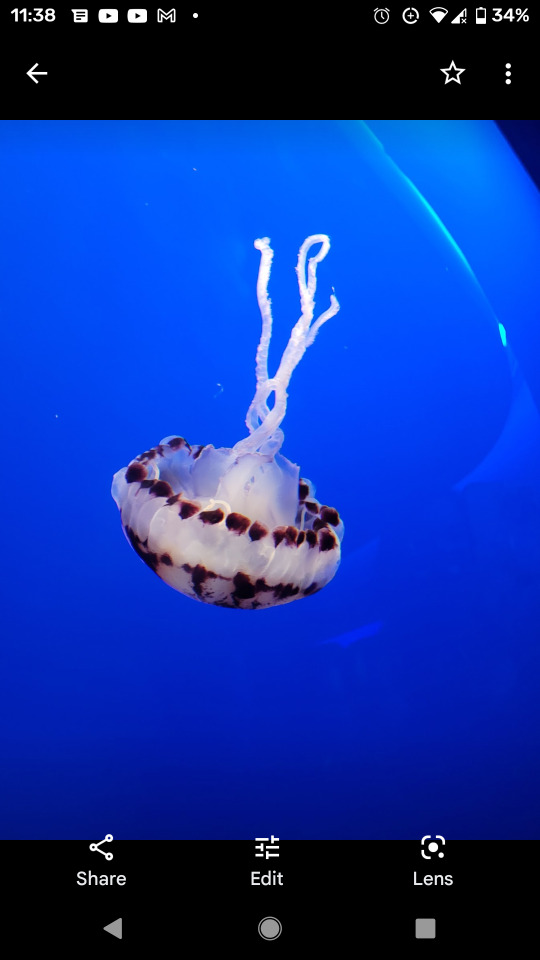
This one's a screenshot because the phone I took it on doesn't save files as png or jpg for some reason?? Whack. Anyway this is a juvenile purple spotted jelly (Chrysaora colorata), classified by the darker spots, small oral arms, and a lack of peripheral tentacles. It's just,,, a lil baby... I love it.
alright, I think that's all I have for now, but I'd like to add some words of my own ehe:
Jellyfish are, regrettably, creatures that aren't often conventionally attractive. Their movements may be rhythmic and hypnotic, but some are off put by the tentacles and their toxicity. I compiled the list with criterium such as "short tentacles" or "small body" but the reality is that the term encompasses an extremely diverse group of animals, and they can be quite freaky or scary.
I don't blame your friend for xyr fear. Jellyfish can be dangerous, and touching them is never recommended (unless you're me, bc you know most of the venomous jellies already lol /j). In that sense I kinda feel a kinship with them, since I don't really like being touched either (sometimes I wish I had deadly venom to prevent other people from making unwantef contact with me ehehe). Anyway, these are definitely species that are a "look, but don't touch" kinda deal.
Still, even just a surface dive in jellyfish lore (ugh, can't believe I'm saying that) makes you step foot into a surprisingly interesting and foreign world. Invertebrates are infinitely interesting, and jellyfish, being one of the oldest, are sure to reveal hidden powers and abilities that one would not even be capable of fathoming.
The optimistic side of me hopes that your friend overcomes xyr fear of jellyfish, but at the very least, I hope that xey can learn to be comfortable with the idea of jellyfish, haha.
#It's a bit difficult to compile a list without knowing exactly what your friend finds scary about jellyfish but hopefully this list helps!#These jellies all have varying levels of toxicity btw but the ones that are not harmful are the hydrozoans I've talked about and the comb-#-jellies#The upside down jellyfish has a reportedly mild sting but depending on the person something as bad as a poison-ivy like rash could develop#Same goes with the Papua jelly - but only slightly#Apparently the cauliflower jelly and Cabbagehead jellyfish don't have a terribly painful sting but they can pack a punch as well#Uh anyway#Hope you found this helpful :). I enjoyed talking about jellyfish#ask#mun rambles#jellyfish
26 notes
·
View notes
Text

I've felt like my art was kinda generic lately, so I've challenged myself to try something truly unique: A series of haut couture looks based on various invertebrates! This one is a Mastigias Papua (jellyfish). It's still a WIP, but I'm very happy so far ^^
[ID: Illustration of a white woman from the waist up. She wears a loose blue-green patterned dress, and a capelet and headscarf reminiscent of a jelly fish's bell. Both are light blue and adorned with several rows of light peach ruffles. The headscarf is open-fronted, but the cape is high-necked enough that her whole neck is hidden. /end ID]
8 notes
·
View notes
Text
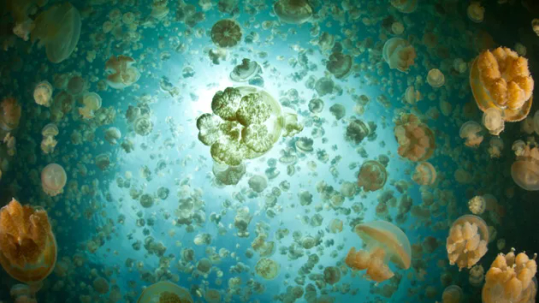
Millions of golden jellyfish (Mastigias papua etpisonii) swim inside an isolated marine lake in Palau.
0 notes
Photo
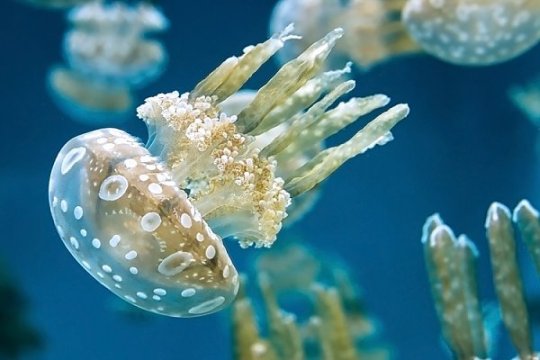
🔥 Spotted lagoon jelly (Mastigias papua), a species of jellyfish widely distributed through the Indian Ocean, China Sea to Japan, and outward over the Pacific to the Fiji Islands
1 note
·
View note
Text
Fun Facts about Jellyfish Can Be Fun For Anyone
Jellyfish Jellyfish have floated along on sea streams for thousands of years, even before dinosaurs resided on the Earth. But what produced jellyfish jelly is not simply that they look like mammals—they are extremely similar. Jellyfish jellyfish come coming from some parts of the sea, like the Gulf of Mexico, where they are one of the very most usual killers for all marine life—but they are even more like mice—and have unique, distinct, and distinctive individualities.
youtube
The jellylike creatures pulse along on sea streams and are bountiful in cold and cozy sea water, in deep-seated water, and along coastlines. The gelatinous creatures can journey coming from one spot to another by strolling under pressure (a process gotten in touch with the'spiral of idleness'). The activity of jellyfish creates it incredibly hard to analyze the minuscule organisms on the sea floor. This results in the'spiral of passivity', which indicates when a tiny living living thing maynot relocate.
But despite their label, jellyfish aren't in fact fish—they're invertebrates, or animals with no foundations. Their physical bodies are covered in little jellyfish bone tissues. Their gastrointestinal system is a gelatinlike body organ phoned a "lobster" that has huge, gelatinlike organs that support the worried body, sight (the ability of the eyes and hearing) and other organs. All the organs are present on the face's frontal surface in jellyfish, or the surface of their mouths.
Common Name: Golden Jellyfish Scientific Title: Mastigias papua etpisoni Type: Invertebrates Group Name: Smack Size: Up to 5.5 inches Jellyfish have small painful cells in their arms to stun or immobilize their prey before they eat them. Stinging cells at that point make discomfort greats to aid deal with the ache. They can easily also disable your own eyes or other sensing units. They require a large amount of water to make it through in bondage.
Inside their bell-shaped body system is an position that is its mouth. The mouth of the monkey is a shallow gap that disperses coming from the pointer of its head to concerning 2 metres. It may hear the world around it but merely when the monkey is moving. The opening that opens up, if a human person is not near the ape, then one can merely read its phrases. It has actually a big lexicon that's continuously being checked out.

They consume and discard refuse coming from this opening. The house obtains black. The rainfall drops. A lengthy time passes before a guy shows up and require the key to one of the spaces from a man in a wheelchair: a secret to a area with no doors and a male in a mobility device. The Latest Info Found Here walks in. The robber knocks out the key and a woman comes in. A man along with a clipboard begins a talk with the woman and talks to what she need to have, leaving behind the female to walk away.
As jellyfish squirt water from their oral cavities they are moved ahead. This creates a jacking activity, which makes the water relocate sluggish. But because the water is attracted gradually from its belly down to the skin layer inside its oral cavity, jellyfish are even more unsafe and extra effective at handling the motion of water than fish. Therefore, jellyfish can operate in blend along with fish. Lucky for them, jellyfish don't eat humans.
Arms dangle down coming from the soft baglike body system and hurt their victim. The stingers after that soar off in the direction of their target, and they then wound themselves in the ribs. All these attacks additionally lead to major trauma to a killer's face and body parts. This is how you get clear of serpent and various other predacious lizards after being bitten. And this is how you get rid of those troublesome pestering serpent and scorpions that will certainly eat you out of spite.
Jellyfish stings can be unpleasant to humans and occasionally extremely dangerous. The only means to prevent the sting is to wash carefully and leave the skin layer clean. The remainder is up to you. The second, practically unmentioned, principle of skin treatment is the essential observation that any kind of stinging is induced by bacteria. Because it is extremely complicated to get rid of painful germs coming from a residing cells, skin layer treatment specialists like Dr. Shri Karasely are going to meticulously clean your skin layer without microorganisms.
But jellyfish don't specially assault human beings. They just carry out what it takes to damage down the barriers they make between themselves and the world's seas. In one of the most productive strikes, a jellyfish tore via the best component of the coral reef at the southerly Pacific doorway and prepared off into area. The assault simply set you back the ship approximately five minutes of crew time.
0 notes
Photo
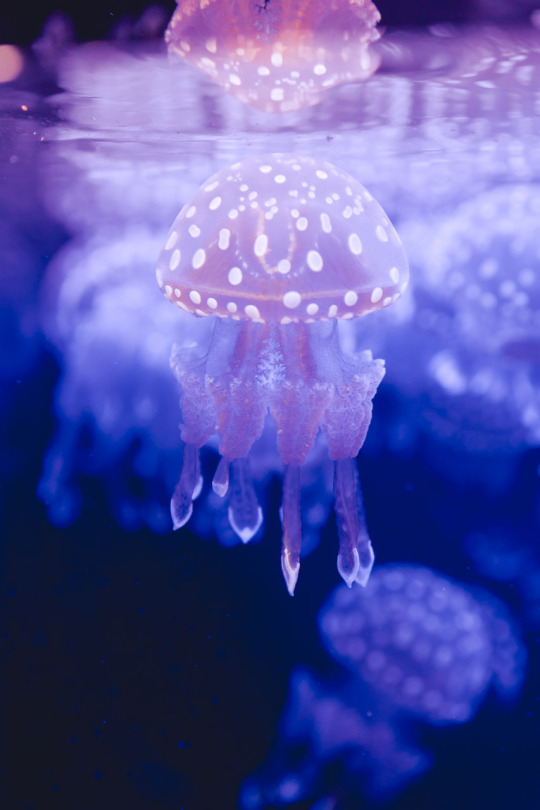
134 notes
·
View notes
Text
Ended up doing a taxonomy thing but I'm not sure if I'll ever properly use it for a post... anyways here's Class scyphozoa for you:

* Subject to change depending on individual species
Order Coronatae: ("Crown")
Tentacles, Lappets, Rhopalia, Mouth, Coronal Groove, Bell
Tentacles typically help up like a spiders'
Usually has 8 ball-like gonads under the bell
Suborder Discomedusae:
Order Semaeostomeae: ("Flag Mouth")
Bell, Oral Arms, Rhopalia, Tentacles
Frilly/ribbon-like oral arms
Order Rhizostomeae: ("Root Mouth")
Bell, Oral Arms, Rhopalia, Filaments
Broccoli-like oral arms
Filaments + Zooxanthallae optional
#.professor jellyfish speaks#jellyfish#art#scyphozoa#i tried to choose jellyfish that best represented each group#periphylla periphylla#chrysaora sp.#mastigias papua#hopefully everyjelly here can differentiate between the main three groups of Scyphozoa now ^-^!!
15 notes
·
View notes
Text
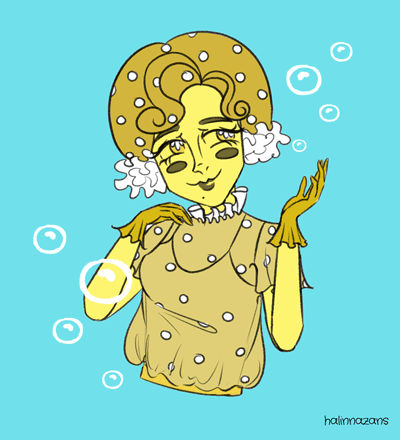
✨Coqueta ✨
2020
Instagram: https://instagram.com/jellykutur?r=nametag
#illustration#ilustracion#ilustracion mexicana#jellyfish#kawaii#digital art#illustrators on tumblr#gif#tumblr gifs#animated#gif art#mastigias papua#original character
2 notes
·
View notes
Photo
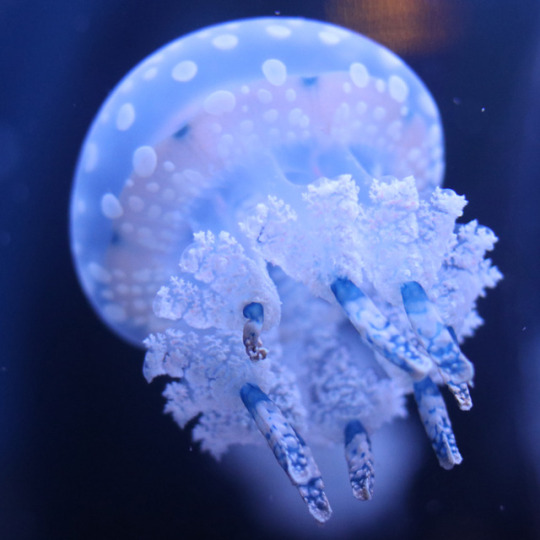

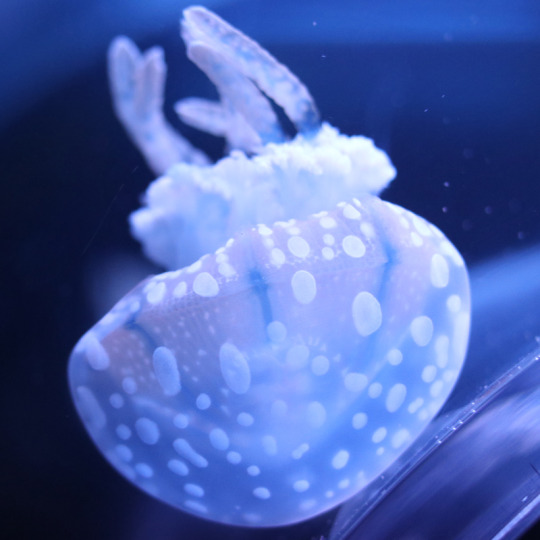
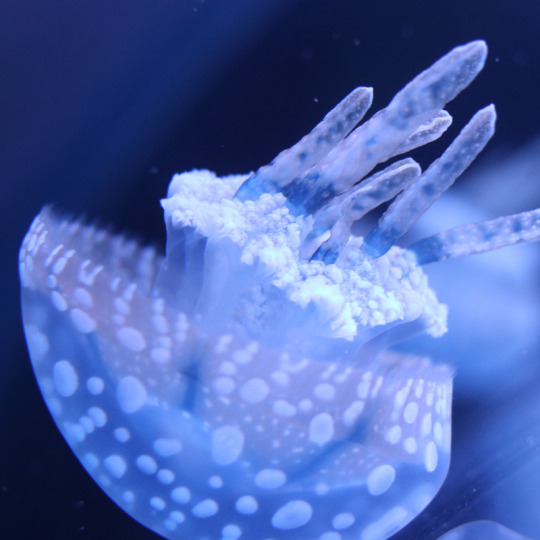
ちょっとだけ青いひといいですねぇ
@東海大学海洋科学博物館
#Papuan jelly#Spotted jelly#Lagoon jelly#Golden medusa#cnidaria#jellyfish#Mastigias papua#東海大学海洋科学博物館
672 notes
·
View notes
Text
@neutrandrogyne
Y'know what? They're pretty much exactly the same but I'll give you the benefit of a separate poll so they can duke it out seperately
#Before the jellyfans get mad at me#They are in the same family so are genetically pretty similar#Like the Cephea cephea and the cotylorhiza tuberculata#Anyways I'll probably need to keep this in mind when I make the jellyfish sexyman bracket lol#Also added vanilla extract because no one is stopping me#Hehe#mun rambles#jellyfish#poll#my polls
11 notes
·
View notes
